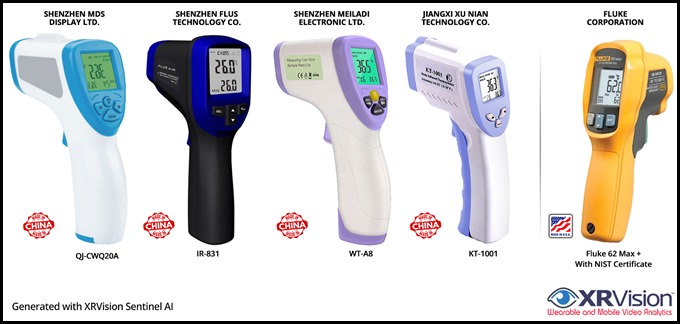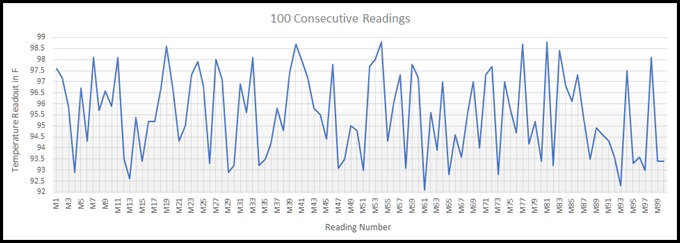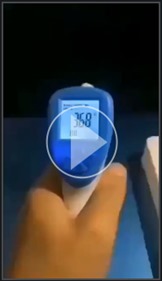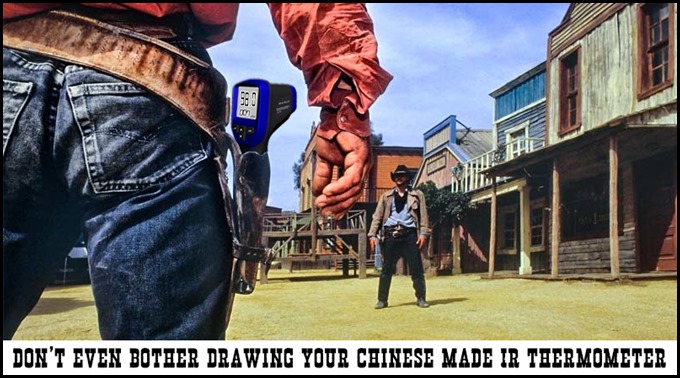A family member in the medical field recently voiced frustration about the low quality of some non-contact infrared thermometers they received. It seem that the entire batch yields consistently lower temperatures when compared to oral thermometers.
I thought that this was strange. Typically, instruments for medical use are certified for accuracy prior to shipment. Considering that these devices come with a certificate of calibration, I reasoned that they shouldn’t produce such discrepancies. Early detection of the onset of high fever is a key factor in Covid-19 patient care. The ability to accurately track body temperature is also critical in determining if a patient is contagious and would trigger decisions regarding treatment, quarantine, and use of PPE gear.
Just like in the case of a faulty car speedometer that displays lower speeds and results in speeding tickets, the usage of faulty thermometers that consistently show lower temperatures can have a detrimental effect on patients and medical staff. Considering that we are in the midst of a severe flu outbreak, I decided to take a closer look. IR thermometers are relatively simple devices that can be easily disassembled and tested, so, I spent a few hours this weekend in the lab digging into the Chinese IR thermometer mystery.
Possible Reasons for Inaccurate IR Thermometer Readings
I do considerable amount of work in the the lab and have at times ran into equipment gremlins. In most cases, there is a simple non-mystical explanation for why test equipment fails. In the case of an IR thermometer this can include:
- The instrument is within the actual variance of its stated accuracy
- The instrument has faulty firmware, sensor, logic circuitry, or other board components
- The instrument is not being used correctly
- There are some unusual environmental conditions that effect the measurement (i.e. humidity)
- The instrument wasn’t calibrated prior to shipment
- The instruments detection range doesn’t cover the object temperate
Test Specimens
For the test samples I’ve selected the top of the line IR thermometers, all in the $60-$140 price range. There are many cheaper units on the market, but, I deliberately went with the higher-end devices because they claim to have been calibrated and certified, to be “Built for Accuracy”, and be “CE FCC RoHS FDA” approved.

Image 1: The IR thermometers used in the evaluation
To keep the test conclusive, I avoided complex correlations of skin to core body temperate or evaluating the thermometer accuracy across a wide range of surfaces and temperate ranges. All of my testing was done in a controlled environment with respect to humidity and temperature and followed an identical sequence of repeatable steps.
The Testing Procedure
- The IR thermometer was kept at room temperature on the workbench where the test was conducted.
- Unit emissivity was set to the range of 0.95-0.97.
- The lens was cleaned before each measurement.
- Distance to Target ratio was kept constant and followed the manufacturer’s recommendation for each unit.
- The IR thermometer was held in a bracket and the lens was pointed at a 90° angle from the surface.
- Each IR thermometer executed 20 consecutive readings with 5 second lap between each reading.
- All measurements were taken at the same location about 1/2” off the inner canthus eye area.

Image 3: Test measurement location and thermal distribution on the human face
Test Results
All of the Chinese made thermometers exhibited a wide range of results. They were inconsistent, fluctuating by as much as 5 degrees between consecutive measurements and frequently erred on the colder side. The Fluke 62 Max IR thermometer performed in a consistent predictable manner and passed the ‘Ice Water’ and ‘Infrared Comparator Cup’ tests within stated tolerances. All four Chinese made IR thermometers failed to pass both of these tests.
Of note is the high-low temperature variation pattern of the Chinese made thermometers. The test population indicates that all four devices were at times able to detect skin temperate of about 96F, but its unclear whey they didn’t do so in a consistent manner.

Chart 1: The results of 20 consecutive skin temperature readouts for the five IR thermometers. A normal range range for skin temperature is 33.5C-36.9C or 92.3F-98.4F
Running 100 consecutive tests on one of the Chines made thermometers (the QJ-CWQ20) shows a distinctive cyclic pattern resembling the output exhibited by some sort of a pseudorandom number generator logic. This could be some sort of a leveling function, but it could also be an attempt by the firmware writer to compensate for poor sensor performance or an evasion mechanism–The IR thermometer equivalent of VW’s dieselgate.

Chart 2: The results of 100 consecutive skin temperature readouts from the QJ-CWQ20 IR thermometer.
Testing the performance of the thermopile detector (the IR sensor) on all devices shows that they functioned properly and returned readings consistent with the Fluke 62 Max sensor.

Image 4: Typical analog thermopile sensor used in the IR thermometers
Based on the consistent thermopile readouts on all devices and the occurrence of the temperature anomalies in only the Chinese thermometers, it’s unlikely that the cyclic pattern of low and high temperature readouts is attributable to individual components and/or circuit design issues.
The four thermometers are made by different vendors, each has different components and board layouts; suggesting that this is some sort of a shared problem. And, if this is the case, then the shared source must be faulty logic or firmware. Either way, this is a critical issue because it renders all of them are unreliable.
Poor Overall Quality and Hostile Intent
Two additional data points that relate to the of faulty Chinese medical equipment theory are the large amount of ‘defective’ Covid-19 test kits and sub standard PPE gear sold in the west. In this context, we can also consider the possibility that these defective devices were shipped knowingly. This is suggested from one discussion on the Chinese DingTalk platform (an Alibaba company) where the topic of conversation was deliberately lowering the IR thermometer threshold for units sold in the US. In this 178 member group chat, Zhang Xuandong, the owner of Haofeng Electronic Technology Co—an IR thermometer producer in Dongguan, Guangdong Province in China—openly talked about waging war against the US. Zhang wrote:
” [Let’s] produce some faulty products and sell them to the US. They (the thermometers) should read 36.5 ºC when the actual temperature is 39 ºC. In this way, more and more American people will be infected. Let’s see if they still have people left to go to other countries to harm others!”
After one member responds with three laughing emojis, Zhang continues:
“Isn’t that a great idea? Without using one single soldier, we can make money, as well as make peace around the world.”
Another member then responds:
“No, we don’t want to make any money from the Americans. Let them help and rely on themselves.”

Image 5: The DingTalk conversation about deliberately lowering the IR thermometer threshold for units sold in the US and Zhang Xuandong, the owner of Haofeng Electronic Technology Co.
Conclusion
Regardless of the root cause of the thermometer poor performance, the fact remains that all of the tested Chinese units were faulty. So, if you need to make critical decisions about patient care, go with a quality device like the Fluke 62 Max. With the Fluke, you will get US based support, a quality warranty, and piece of mind that your thermometer will work in a consistent and predictable manner. Regardless of make and model, unless you certify the gear independently, stay away from Chinese IR thermometers. The same advice also applies to other Chinese medical testing equipment.

Image 6: Typical claims made by a Chinese IR thermometer manufacturer selling on Amazon regarding precision, FDA approval, and accuracy

Image 7: False claims made by Chinese IR thermometer manufacturers sold on Amazon regarding performance and clinical testing and certification

Video 1: The magic Chinese thermometer that always reads 36.X degrees. The unit doesn’t have actual thermometer components
References and Sources
XRVision Sentinel AI Platform – Face recognition, image reconstruction, and object classification
A Note About Core Body vs. Surface Temperature
Anyone who has experimented with baking a thanksgiving turkey knows that a thermometer inserted into the center of a turkey will yield a different temperature than taking a surface measurement with an IR thermometer. Similarly, pointing an IR thermometer at human skin will not yield a reading of 98.6°F but rather something closer to 93°F or 96°F. This reading can depend on many factors such as skin reflectivity, moisture, hair, etc. (a reading of approximately 98.6°F is considered ‘core’ body temperature and must be measured in a body orifice.)
Temperature Baseline Verification Procedures
As part of benchmarking the IR thermometers, I’ve used the following two test procedures to establish the baseline for each device:
Ice Water Test
The purpose of this test is to determine if the IR thermometer can accurately read the water/ice temperature of approximately 32.0°F. To perform this test, I followed these steps:
- Filled a glass with crushed ice and added water to fill the gaps between the ice cubes.
- Allowed the ice/water to rest for 120 seconds.
- Stirred the mixture to get uniform distribution of water and ice.
- Attached the infrared thermometer to a holder located over the top of the ice/water at a distance of 3″ with the lens at a 90° angle and centered it over the ice/water.
- Took 10 consecutive readings at 10 second increments
Infrared Comparator Cup
The purpose of this test was to compare the accuracy of an infrared thermometer to a calibrated immersion type thermometer at a temperature other than that of ice/water. The reading of the IR thermometer should match that of the reference thermometer within the stated specifications. To perform this test, I followed these steps:
- Used a machined aluminum cup with a flat surface with a solid matte black coating. The cup walls shield the surface from air currents in the room and the mass of the base provided for temperature stability.
- Inserted the reference thermometer and allowed it to stabilize for five minutes.
- Pointed the IR thermometer at the target inside the cup using the same distance and geometry as with the Ice Water test.
- Took 10 consecutive readings at a 10 second increments
Copyright 2020 Yaacov Apelbaum, All Rights Reserved.



https://www.thegatewaypundit.com/2020/03/chinese-company-that-makes-forehead-thermometers-jokes-about-making-faulty-product-for-sale-in-us-in-order-to-spread-disease/
My China made cheap non contact Acu Rite registers close using it on a glass of ice water, but not even close on a human forehead/armpit. I use it for temps out of AC registers, bearings and other odd temp readings where it does not need to be precise.
It does matter the distance you hold it from, the consistent #’s for mine is mostly at 10-12″. But for some reason the human body does not register well, it is off by a lot. I just did the back of my hand 84 and the inside wrist 88 and my armpit 84, forehead 88.
Metene(China does not have a visible light beam) forehead temp probe needs to be pressed on skin, back of hand 83.9, inside wrist 95.7, forehead 96.8, armpit 98.4. 4″ off of skin measures 4-6 deg less at least
I put my quick response cooking Therma Pro on my skin and it measured close to the same in all areas as Acu Rite except 91 on my forehead.
Acu Rite in glass of ice water after 5 minutes was 34, Metene(on ice cube) 35.1, Therma Pro measured 32.9.
Thanks for you comment John,
When conducting the tests, i followed the user guide for the recommended distance and angle so, these variables should be eliminated. The problem with these Chinese ‘medical’ IR thermometers is that they make specific claims about accuracy and calibration certification. Both of these turn out to be false and misleading. BTW, these are not cheep $30 units, they are top of the line devices that sell for $90-$120 and claim to be FDA approved. My take on this is that something as egregious at this should trigger a negligence class action lawsuit against the Chinese manufactures and their distributors in the US.
I am beginning to hate these people
Curious why you performed your Cup Comparator test in a matte black aluminum cup (attempting to duplicate the “black-body standard” for IR calibration?), but then took the measurement off the reflective surface of the water?
The “Ice Water Test” and “Infrared Comparator Cup” test are two separate verification tests. They are independent of each other. The problem that they try to solve is the determination if the device is calibrated by comparing it to a known baseline.
Thanks for your work. The only thing I think could be done differently is: instead of using the back of your hand instead test the thermometers on a crock pot, controlled temperature at 98.6 F, of chicken breasts.
Thanks for your comment D.
The problem with using a crock pot with chicken breasts in it is that the Chicken would heat and radiate unpredictably (hotter closer to the metal colder at the surface. You would also have problems getting an accurate temperature from the heating element. When the dial on the crock pot give you a value, its calibrated and can be off be a few degrees.
A chicken breast is also a poor simulator for the human anatomy (i.e. lack of blood vessels, fat, muscle, skin, hair, etc.). Keep in mind that all Chinese thermometers failed both calibration tests and skin temperature tests. The Fluke thermometer on the other hand, had no problems reading the correct temperature in all tests. Finlay, having a hot chicken breast in the lab would have been an irresistible temptation and I would have probably eaten it.
lol Thanks again for your work!
We keep dismissing the idea of this being a bio-weapon. What if you were not looking to wipe out a population, but an economy?
What if you also happened to be the key supplier of medical supplies?
How much longer and impactful would the outbreak in each country be if you coupled it with faulty masks, some supply of pre-infected swabs packaged with an already poor accuracy test? And then a randomly adjusting IR thermometer? Seems the strategic placement of such artifacts would ensure other countries would suffer a more amplified amount of damage.
We are all being conditioned to not dare accuse China of attacking us with premeditation, and even not accuse the lab of being the source.
We may never know if the breach was purposeful or accidental, BUT EVERY OTHER ACTION SINCE – seems to have been badly motivated, if not outright malevolent
Bad ppe, infected testing, withholding info, coercing who to give false info, closing internal flights but not external.etc…
From our perspective: what is the difference between a Attack from China vs an accidental release form China in terms of their official behavior? would it be different? And would the damage be different?
I agree, taking advantage of the pandemic that is directly traced to a virus that originated from their own lab and suppressing the truth about the outbreak and spreading disinformation, cornering the market in PPE equipment, and knowingly shipping defective medical supplies (and making a fortune on it) is warfare.
Had a thought: If this actually was purposeful, then the temp they would try to hide is that of a fever. i wonder if you tested it against a target of 99-102 and that range displayed more erroneous readings than “normal” human temp ranges -say 94-98, then it might be more proof toward maliciousness.
No, didn’t try to locate the optimal range for these devices. I was only trying to determine if they are consistently accurate and if there is some logic to the variation in readings. I think that the FDA should step in and conduct a large scale testing of Chinese based medical equipment. If this is indeed as prevalent as the test sample suggests, they should ban all this equipment from the US and bring an action against the manufactures and distributors.
I noticed that kitchen staff donned with PPE go to a dump master to get rid of empty boxes and then return with the trolley to the kitchen. And to me this explains why certain nursing homes have an outbreak claimed to be from COVID- 19 but may be really from a bacterium such as like with the Legionnaires Disease. This because once with their gloves they touch the dump-master they contaminate the gloves but ignoring this then with those gloves go back into the kitchen now spreading the bacterium around. This is likely why in Australia 300% were infected, this because when staff are signing off and new staff attend they too become infected and so all residents. Blame it on COVID- 19
, when in reality it is a lack of proper “house keeping”. I also witnessed in the hospital a nurse dropping her mask onto the floor and then putting it back onto her face. Meaning to have all dirt now on her mask. My wife is 88 and a heart patient and has many other health issues and neither of use are using mask, this because by not wearing a mask we prevent contamination far more and not causing a restriction to our oxygen, etc. Also, I noticed that face masks/face diapers are made in slums and dumped on a carpet before being packed. The dust of the slums then is into the masks. Not particularly healthy to use those mask. The best way in my view to stay healthy is to be POSITIVE minded.